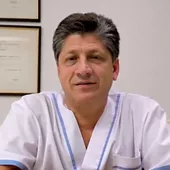“Esthetic rehabilitation of the anterior segment is one of the biggest challenges of modern restorative orthodontics. An artificial gum can be a quick, simple and cheaper solution for missing gum tissue restoration. It makes guided bone regeneration and mucous, gingival and periodontal surgery unnecessary, options which may not be suitable for some patients. It represents a new way of viewing and planning clinical cases for the entire rehabilitation team – surgeon, prosthetist and dental technician.” Troiano/Cagnone
Initial situation
The patient, a 67 years old female, presented for consultation to treat her edentulous maxilla with an implant-supported fixed prosthesis. Managing such a complex clinical case can be difficult, even with clear diagnostic parameters and a sensible treatment plan. A two-stage surgical approach involving bone and soft-tissue grafts to provide enough soft-tissue conditioning, does not always guarantee success of good final aesthetic result. In this case that we are presenting, it is necessary to use other prosthetic devices, such as artificial gum to biomimetically [1,2] restore the patient’s aesthetics and function.
Treatment planning
To reach an accurate diagnosis and develop an appropriate treatment plan using artificial gum for reconstructive purposes, it is necessary to take the initial steps: 1. Perform a clinical examination. 2. Take extra-oral photographs of the patient’s frontal perspective and side profile, with and without her upper prosthesis (Fig. 1 a-f). 3. Take intra-oral photographs (Fig. 2 a-f) with and without the existing upper prosthesis. 4. Take impressions to create the study models (Fig. 3 a-d). 5. Record her occlusion to articulate the study models. 6. Consider the possibility of using artificial gum. 7. Do a diagnostic wax-up. The diagnostic wax-up is a critical tool for: 1. Determining the best approach to treatment, as well as for deciding on which surgical or prosthetic procedures to carry out. 2. Providing the dentist with relevant information and acting as a template to take accurate radiographs. 3. Designing the surgical guide. 4. Creating a temporary prosthesis. 5. Analyzing the most appropriate implant position and axis to enable continuity between the artificial gum and the patient’s own hard and soft tissues. 6. Determining the design of the framework for creating the pink acrylic gum and artificial ceramic teeth. Hence, the diagnostic wax-up should be designed to achieve the ideal dental proportion and position without relying on the current position of alveolar ridge. By positioning the teeth ideally in the diagnostic wax-up and providing a radiographic guide before taking the CBCT, the oral surgeon can obtain 3D images (Fig. 4 a-d). to assess the bony tissue and determine the surgical approach. Establishing the appropriate number of implants and their position are critical to establish the right approach to successful gingival prosthetic restoration. The less number of implants used, the easier it is to restore the arch, as this means fewer posts and more pontics. As long as biomechanics are not jeopardized, limiting the number of implants gives the lab technician more freedom to shape the anatomy of artificial gum to facilitate patient hygiene practices. Another good reason for choosing a screw-retained prosthesis is the ability to retrieve the prosthesis for maintenance, and assessment of the patient’s oral hygiene (Fig. 5 a-f). The angle of placement of the implants must facilitate screw access from the lingual side for a screw-retained prosthesis. The dental technician can shape the emergence profile of the abutments, and the aesthetic material can be placed closer to the implant shoulder. The vertical position of the implant is a critical factor for achieving functional and aesthetic restoration. In conventional implant restorations, the implant shoulder is usually 2-3mm below the cervical border of the crown. When using the artificial gingival reconstruction, the implant shoulder must be more than 3mm beyond the cervical margin of artificial gum with the tooth. The greater the lack of horizontal soft tissue height, the deeper the surgeon will have to place the implant to achieve a harmonious gingival profile. Creating a 30° to 40° artificial gum angle in relation to the occlusal plane, will help to prevent food from getting caught in the area and allow good upper-lip mobility. Summary of important points to consider in treatment planning: Surgical esthetics: amount of hard and soft tissue in the implant area. Dental aesthetics: determining the location of dental restoration and use of artificial gum. Facial aesthetics: facial profile of the patient must be taken into account when planning the prosthetic restoration
Surgical procedure
Two separate flaps were raised in the upper left and upper right maxillary region from the canine to molar region, including two small vertical-relieving incisions to obtain enough tissue for closing and minimum post-surgical inflammation. Eight Ø3.3 and 4.1 mm diameter, 10 or 12 mm long Straumann Bone-level Roxolid® implants were placed , following the Straumann surgical protocol (Fig. 6 a-f). The location of the implants, between the canine and the molar area on both sides of the arch, was selected based on the treatment plan and with the aim of being able to work freely on the midline while giving the pink porcelain the right volume for esthetic defect compensation in fully edentulous patients. A synthetic bone graft (Straumann® BoneCeramic) and a bovine collagen membrane were placed in the vestibular plate of the surgical areas to compensate for bone dehiscence caused by prosthetically-guided implant placement, using a 5-0 nylon suture.
Prosthetic procedure
At sixty days post-surgery, the implants were exposed via minimal incision at the top of the ridge in two sections resembling that of the initial surgery and installed directly the healing abutment , so that the gum would adhere well and the soft tissue would be healthy for the foreseeable future. Three months later, an impression was made using the conventional open-tray impression technique. A working model was created and 8 Bone Level cementable abutments were placed on the implants, two of them at a 15° angle (Fig. 7 a,b). After prepping them, a CAD/CAM cobalt-chrome superstructure was constructed, including pink and white porcelain. For recoverability, the holes were made in the vestibular area in the upper third of the pink ceramic. The aesthetic aspect was not compromised because pink resin was used for sealing these screw channels.
Final result
(Fig. 8 a,b, Fig. 9 a-d): Clinical success with the use of pink gum restoration depends on the precise planning of prosthetic surgical steps with careful consideration of both surgical and prosthetic aspects. Temporary restoration is an important step in planning an artificial gum procedure. Temporary teeth or gum are essential for treatment. It is important to resolve any hygiene or maintenance concerns with the temporary teeth or gum already in position. Emergence profiles are key to artificial gum restoration. The aim is to create a buccal contour in which the artificial gum looks like the patient’s own gum before the loss of teeth. The artificial gum should rise from the implant and form an acute angle after crossing the transmucosal area. This will help breach the gap between natural and artificial soft tissue. To have enough space for hygiene purposes in an edentulous patient, it is necessary to take special care when creating the artificial gum during the different instances of the overall process . Final artificial gum touch-ups are done directly on the patient’s prosthesis in the mouth. (By using a thin diamond bur, the edge of the artificial gum can be trimmed to have it match the patient’s own gum, if the shape and sulcus of the latter area is greater (twice as much). The surface in contact with the gum must be shiny, smooth and free of any concavities. A flat or oval surface is recommended for areas in contact with natural tissue. Another consideration is related to the choice of material for the artificial gum: composite, ceramic or hybrid.
There are a number of reasons for selecting a composite material: 1. It preserves the physical properties of the porcelain fused to metal restoration 2. The pink aesthetic shade, shape and texture can be controlled 3. It facilitates maintenance and repair, without affected the ceramic crowns 4. Predictable results.
Ceramic restorations cannot be screw-retained due to anatomical and angle difficulties; therefore, it needs to be cement-retained. When only a small amount of gum is required, such as part of a papilla, it is easy to add pink ceramic while working on the crowns. However, when a large amount of artificial gum is necessary in order for the transition line to be outside of the aesthetic zone, it is advisable to use ceramic. When using a hybrid material, the pink core is done in ceramic and a composite overlap preserves the aesthetic aspect, giving maximum interface control. The soft-tissue interface and the mesostructure are done in pink ceramic, facilitating sub-gingival biocompatibility. Pink composite is only used supra-gingivally, so that is matches the aesthetic interface. [3,4]
Conclusion
Esthetic rehabilitation of the anterior segment is one of the biggest challenges of modern restorative orthodontics. Artificial gum can be a quick, simple and cheaper solution for missing gum tissue restoration. It makes guided bone regeneration and mucous, gingival and periodontal surgery unnecessary, options which may not be suitable for some patients. It represents a new way of viewing and planning clinical cases for the entire rehabilitation team (surgeon, prosthetician and dental technician). Diagnostics and planning are essential for applying this technique, since implants, including implant-placement, must be conceived specifically for this restorative system. Case selection is important and requires patients who are willing to keep up oral hygiene and engage in prosthetic maintenance. Artificial gum can predictably achieve a harmonious gum tissue anatomy where such tissue is missing by reproducing the actual color, contour and texture of the patient´s gum. The patient must understand the application and scope of the restoration before the treatment begins. Less clinical steps and surgical risks, since vertical bone crest growth is not the purpose of this particular treatment. This method aims at greater esthetic predictability with less clinical steps.

